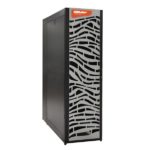“Managing the work on each node can be referred to as Domain parallelism. During the run of the application, the work assigned to each node can be generally isolated from other nodes. The node can work on its own and needs little communication with other nodes to perform the work. The tools that are needed for this are MPI for the developer, but can take advantage of frameworks such as Hadoop and Spark (for big data analytics). Managing the work for each core or thread will need one level down of control. This type of work will typically invoke a large number of independent tasks that must then share data between the tasks.”
Extreme-scale Graph Analysis on Blue Waters
George Slota presented this talk at the Blue Waters Symposium. “In recent years, many graph processing frameworks have been introduced with the goal to simplify analysis of real-world graphs on commodity hardware. However, these popular frameworks lack scalability to modern massive-scale datasets. This work introduces a methodology for graph processing on distributed HPC systems that is simple to implement, generalizable to broad classes of graph algorithms, and scales to systems with hundreds of thousands of cores and graphs of billions of vertices and trillions of edges.”
Overview of the MVAPICH Project and Future Roadmap
In this video from the 4th Annual MVAPICH User Group, DK Panda from Ohio State University presents: Overview of the MVAPICH Project and Future Roadmap. “This talk will provide an overview of the MVAPICH project (past, present and future). Future roadmap and features for upcoming releases of the MVAPICH2 software family (including MVAPICH2-X, MVAPICH2-GDR, MVAPICH2-Virt, MVAPICH2-EA and MVAPICH2-MIC) will be presented. Current status and future plans for OSU INAM, OEMT and OMB will also be presented.”
Cray Urika-GX System to Tackle Big Data Analytics
“We took the Aries system interconnect from our supercomputers, the industry-standard architecture of our clusters, the scalable graph engine from the Urika-GD appliance, and the pre-integrated, open infrastructure of our Urika-XA system and combined them into one agile analytics platform. The Urika-GX gives our customers the tool they need to overcome their most advanced analytics challenges today, and the platform to bridge to tomorrow.”
RCE Podcast Looks at the Impala Project
In this RCE Podcast, Marcel Kornacker from Cloudera describes the Impala project. Impala brings scalable parallel database technology to Hadoop, enabling users to issue low-latency SQL queries to data stored in HDFS and Apache HBase without requiring data movement or transformation. Impala is integrated with Hadoop to use the same file and data formats, metadata, security and resource management frameworks used by MapReduce, Apache Hive, Apache Pig and other Hadoop software.
Video: Exploiting HPC Technologies to Accelerate Big Data Processing
“This talk will present RDMA-based designs using OpenFabrics Verbs and heterogeneous storage architectures to accelerate multiple components of Hadoop (HDFS, MapReduce, RPC, and HBase), Spark and Memcached. An overview of the associated RDMAenabled software libraries being designed and publicly distributed as a part of the HiBD project.”
Learn Apache Hadoop with Spark in One Day
Hadoop and Spark clusters have a reputation for being extremely difficult to configure, install, and tune, but help is on the way. The good folks at Cluster Monkey are hosting a crash course entitled Apache Hadoop with Spark in One Day. “After completing the workshop attendees will be able to use and navigate a production Hadoop cluster and develop their own projects by building on the workshop examples.”
Florida Atlantic University Selects Bright Cluster Manager for HPC
Today Florida Atlantic University (FAU) announced that it is using Bright Cluster Manager software for its HPC cluster. The 56-node cluster is used for teaching Hadoop Map Reduce, bioinformatics research and other modeling and visualization work. Administrators say Bright Cluster Manager has significantly increased automation and is easily scalable to meet expected future growth.
Chalk Talk: What is a Data Lake?
“If you think of a data mart as a store of bottled water – cleansed and packaged and structured for easy consumption – the data lake is a large body of water in a more natural state. The contents of the data lake stream in from a source to fill the lake, and various users of the lake can come to examine, dive in, or take samples.” These “data lake” systems will hold massive amounts of data and be accessible through file and web interfaces. Data protection for data lakes will consist of replicas and will not require backup since the data is not updated. Erasure coding will be used to protect large data sets and enable fast recovery. Open source will be used to reduce licensing costs and compute systems will be optimized for map reduce analytics. Automated tiering will be employed for performance and long-term retention requirements. Cold storage, storage that will not require power for long-term retention, will be introduced in the form of tape or optical media.”
Scientific Cloud Computing Lags Behind the Enterprise
“In business and commercial computing, momentum towards cloud and big data has already built up to the point where it is unstoppable. In technical computing, the growth of the Internet of Things is pressing towards convergence of technologies, but obstacles remain, in that HPC and big data have evolved different hardware and software systems while Open Stack, the Open Source cloud computing platform, does not work well with HPC.”













